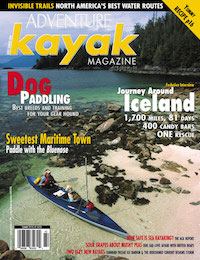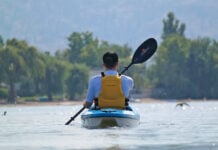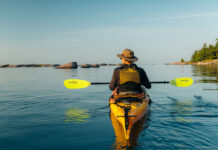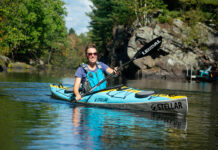Last summer my wife Kelly and I began the paddling trip of a lifetime. We completed the first two weeks of a voyage along the entire coast of B.C. We chose to do the most exposed section first— from Port Hardy on Vancouver Island’s north tip to Bella Bella on the Central Coast. Our charts showed places like Skull Cove and Cape Caution, and we had envisioned a lonely, desolate coastline, pounded by surf from Japan, littered with wrecks of kayaks and ships alike. Instead, we were surprised to meet all manner of folk (with the odd exception of sea kayakers), including commercial fishermen, a solo explorer piloting a Zodiac from Alaska to Seattle, and a wonderful group of Heiltsuk people from Bella Bella running a native rediscovery camp. They expressed mild surprise to see us in our double folding kayak bob- bing around in the surf, but were completely taken aback when I opened the zipper on my sprayskirt and our dog Lucia stretched and popped out for some fresh air.
Yes, you can paddle with your pet! Cats, with their nasty propensities to urinate on, spray, claw, and generally devalue property, are pretty much out of the question, in my opinion. But a dog—man and woman’s best friend! Dogs are truly social animals that can adapt themselves to pretty much any situation—ski touring is akin to dog heaven, river rafting is like pooch Nirvana, and extended sea kayak trips are like one giant rotten salmon carcass to roll in.
Kayaking with your hound can either be Milk-Bones and rawhides for both of you, or it can be like one long, drawn-out shock collar for both pet and owner. To tip the scales toward the Milk-Bone side, paddlers need to spend time choosing the right dog, invest thought and care into training, and plan trips with their pet in mind.
When it comes to choosing the ultimate paddling pooch, size does matter. Large breeds, such as rottweilers, shepherds, and huskies will likely require their own custom hatch or even their own cockpit, and will tend to make life interesting if the paddling gets bumpy. Smaller breeds, such as border collies, blue heelers, and smaller labs and retriever cross-breeds can often fit in a cockpit with a paddler, and will therefore be easier to control if paddling conditions become more challenging.
When we finally gave in to the tiny newspaper ad that proclaimed “Border Collie Cross Pups!” We examined each of the six little fur balls in the litter to check their foot size—puppies will tend to grow into their feet—to choose a smaller dog that would be comfortable in a kayak cockpit.
And so little Lucia entered our life. The training with a puppy begins at once, and I believe that training is more about building a connection between you and your pet than teaching banal skills such as “sit” and “roll over.” From day one, Lucia went where we went. By the time the local lakes and rivers opened up for paddling, she already had nearly 50 ski-touring days under her pelt (even though she spent most of these with nothing but her head poking out of my day pack). When we finally did try to teach her basic commands, it was painless, as she inherently knew when we were happy with her or otherwise.
We wondered how Lucia would do in a kayak, so as soon as conditions allowed we put our sea kayaks into the St. Mary’s River near our home in Kimberley, B.C., and floated 15 kilometres downstream with our dog soundly asleep on an Ensolite pad between my legs.
Next came the training for the worst-case scenario—a dump in rough water. We wanted to give Lucia every possible advantage, so we borrowed a CFD (canine flota- tion device) and spent many sweltering summer afternoons swimming various sets of rapids with her, allowing her to get used to mixed-up water, and training her to stay with us while we swam.
The southern Inside Passage was our first extended sea kayak expedition with Lucia. We paddled a Klepper tandem kayak because its 14-inch depth gave Lucia more room to get comfortable on longer paddling stretches.
An important piece of gear is a sprayskirt with a waterproof zipper. This allows the dog to get “above- deck” to get some fresh air on calm seas— would you want to be locked under your sprayskirt after beach burrito night?—and allows you to close up the cockpit if waves begin to wash over your deck.
We learned there are many things to consider when bringing a pet into a wilderness area. It is critical to have a dog that is well-trained and easy to control. The wild West Coast is home to a vivid abundance of wildlife. Every beach is at least a temporary home to sandpipers, turnstones and other shorebirds that a poor- ly trained dog would just love to chase—an ultimate sin from a no-impact standpoint. Every beach also bore the tracks of cougar, grizzly, black bear or wolf, and some- times all of the above! Any wandering away from camp a dog might do could be its last, so if a dog can’t stay put, it should be leashed.
Dogs have all the basic needs that we do—food, water and shelter. Although the dog will find all man- ner of rotten flotsam to ingest, it needs to have its regu- lar diet kept up. On a cold, wet trip, dogs will need more food than normal, just like us. We usually bring a regular ration of Lucia’s regular dog food—which for a long trip can be a daunting amount of extra food to pack—and supplement it with the some of the fresh fish we catch and eat ourselves.
A thirsty dog’s first encounter with salt water can have explosive results, but it is a lesson that the dog will likely have to learn on its own. Just pray that the purging from both ends does not occur in the middle of a long crossing. It is your responsibility to ensure your dog has access to fresh water, either from creeks near camp, or your own supply. A collapsible nylon water dish takes up almost no space, and can double as a food dish.
It is a romantic notion to sleep with your dog in a tent, but a salty sea-dog that has rolled in the unidentified carcass washed up on the beach will likely not be welcome with the humans, no matter what manner of West Coast deluge is happening outside. Therefore it’s a good idea to bring a tent with a generous vestibule for the stinky hound.
We chose our ultimate paddling pooch carefully, and spent months working with her to ensure that she could be a part of the low-impact travelling we enjoy.
Since then, we have met other guides who actually take their pets to work! One friend has taken his dog, Honey, with him while he guides multi-day kayak trips in Nootka Sound on Northern Vancouver Island, and another friend’s dog, Chewy, gets to river-raft the Elk, St. Mary’s, and Bull Rivers all summer with him. We have even had a blind guest bring his seeing-eye-dog on a two-week guided trip to Ellesmere Island!
We learned that with a little preparation, and a lot of training, you can share your adventures with your dog, and hopefully never again have to see a pair of sad eyes watch you from a kennel window as you head out on another grand adventure without them.
Itinerant guide, biologist and frequent Adventure Kayak contributor Dave Quinn lives in Kimberley, B.C. with Kelly Comishin and Lucia the salty dog. Dave and Kelly operate Treehouse Outdoor Education, specializing in adventure and wilderness therapy.









